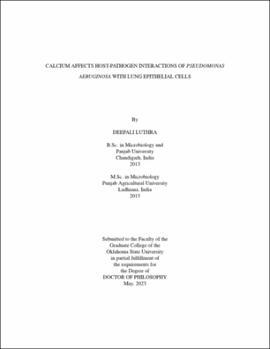| dc.description.abstract | Pseudomonas aeruginosa is one of the key bacterial pathogens that cause acute, chronic, and lethalinfections in the lungs of patients with cystic fibrosis (CF). P. aeruginosa adheres to the mucosal
epithelium of the airways to initiate infections, eventually internalizing and establishing a niche.
Ca²⁺ is a potent cellular signal has been shown to exist in abundance in pulmonary fluids of CF
patients and trigger the expression of virulence factors in P. aeruginosa. However, its role in the
regulation of host-pathogen interactions is not well understood. In this dissertation, we study the
role of Ca²⁺ in adherence, invasion, and intracellular replication of P. aeruginosa in lung epithelial
cells and its role in the regulation of virulence factors (expression of virulence genes, flagella, and
biofilm production) during infection. Two human lung epithelial cell lines, A549 and CuFi-5 (homozygous
for the Δ508 mutation in CF) cells infected with PAO1 and FRD1 strains in low and high
Ca²⁺ conditions were used for this study. We employ the adhesion assay, immunofluorescence,
and scanning electron microscopy (SEM) to study the adhesion of P. aeruginosa to lung epithelial
cells. The data suggests a significant increase in adherence in high Ca²⁺ with both cell lines. A
similar observation was made with the invasion and escape studies. Ca²⁺ binding protein, EfhP,
is reported to regulate invasion, intracellular survival, and escape, whereas it plays an insignificant
role in adherence. Transcriptome sequencing (RNA-seq) and quantitative RT-PCR analysis also
help to understand the importance of Ca²⁺ in the regulation of adhesin transcription (fliC, pilA
and lecA), but this response depends on bacterial strains and the cell line. The Ca²⁺-dependent
upregulation of fliC leads to an increased proportion of flagellated bacteria within a population.
Ca²⁺ also upregulates other virulence factors of P. aeruginosa that could aid biofilm production,
biomineralization, and the production of reactive oxygen species. Here, we provide evidence for
P. aeruginosa host cell escape and Ca²⁺-mediated activation of P13K and Akt that results in P
aeruginosa invasion and intracellular survival within lung epithelial cells. Our study provides insight
into understanding the regulatory potential of Ca²⁺ and Ca²⁺ binding protein, EfhP, in P.
aeruginosa infections during CF. | |
